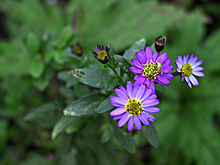Aster ageratoides
| Aster ageratoides | |
|---|---|

| |
| Scientific classification | |
| Kingdom: | Plantae |
| Clade: | Tracheophytes |
| Clade: | Angiosperms |
| Clade: | Eudicots |
| Clade: | Asterids |
| Order: | Asterales |
| Family: | Asteraceae |
| Genus: | Aster |
| Species: | A. ageratoides
|
| Binomial name | |
| Aster ageratoides Turcz.
| |
| Subspecies | |
|
List
| |
| Synonyms[1] | |
|
Aster trinervius subsp. ageratoides (Turcz.) Grierson | |
Aster ageratoides (common name, balsam aster)[2] is a perennial flowering plant in the family Asteraceae. It is endemic to eastern Asia.[1]
Description
[edit]A. ageratoides is a clump-forming, herbaceous perennial growing to a height of approximately 75–90 centimetres. Leaves are dark green, toothed, lanceolate and entire.[3] Flowers are stellate, generally violet, pink or bluish in colour, with yellow centres, flowering from early to late autumn.[2] Fruit is an achene, brown in colour, measuring about 2–3 millimetres in length.[4]
Distribution and habitat
[edit]A. ageratoides is widely distributed throughout Asia, including China, Korea, Japan, Taiwan, where it is usually found in mountainous regions at elevations between 1500 and 2500 metres.[5][6]
Medicinal use
[edit]Ongoing research suggests that Aster ageratoides extract may help attenuate Alzheimer's disease-associated cognitive deficits and improve the symptoms of vascular dementia.[7]
References
[edit]- ^ a b "Aster ageratoides Turcz". Plants of the World Online. Royal Botanic Gardens, Kew. Retrieved 19 October 2024.
- ^ a b "Aster ageratoides". www.chicagobotanic.org. Retrieved 4 September 2024.
- ^ "Hortipedia – Aster ageratoides". en.hortipedia.com. Retrieved 4 September 2024.
- ^ Soejima, Akiko; Peng, Ching-I (2004). "Aster ageratoides". Flora of Taiwan. Retrieved 4 September 2024 – via eFloras.org, Missouri Botanical Garden, St. Louis, MO & Harvard University Herbaria, Cambridge, MA.
- ^ "Aster ageratoides 'Asran' - The Plantsman's Preference". www.plantpref.co.uk. Retrieved 16 October 2024.
- ^ "Aster ageratoides Turcz". World Flora Online. Retrieved 16 October 2024.
- ^ Jeong, Ji Heun; Lee, Seung Eun; Lee, Jeong Hoon; Kim, Hyung Don; Seo, Kyung-Hae; Kim, Dong Hwi; Han, Seung Yun (30 June 2020). "Aster ageratoides Turcz. extract attenuates Alzheimer's disease-associated cognitive deficits and vascular dementia-associated neuronal death". Anatomy & Cell Biology. 53 (2): 216–227. doi:10.5115/acb.20.011. ISSN 2093-3665. PMC 7343560. PMID 32647089.
